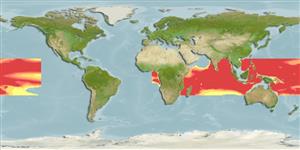Malacostraca |
Decapoda |
Acanthephyridae
Environment: milieu / climate zone / depth range / distribution range
Ecology
Bathypelagic; depth range 200 - 3716 m (Ref. 96667). Deep-water; 20°N - 24°S, 2°E - 131°W (Ref. 97331)
Indo-Pacific.
Length at first maturity / Size / Weight / Age
Maturity: Lm ? range ? - ? cm Max length : 2.5 cm CL male/unsexed; (Ref. 97331); 2.3 cm CL (female)
The large and stout body is covered uniformly with fine pits, which are marks of the attachment of small lanceolate scales. The rostrum is usually shorter than the carapace. The branchiostegal spine is small, supported by a very small carina. A distinct dorsal carina is present on the second to sixth abdominal somites. The carinae of the third to sixth somites ends in large teeth. The telson bears 3 pairs of dorsolateral spines.
Minimum depth from Ref. 96741.
Life cycle and mating behavior
Maturity | Reproduction | Spawning | Eggs | Fecundity | Larvae
Members of the order Decapoda are mostly gonochoric. Mating behavior: Precopulatory courtship ritual is common (through olfactory and tactile cues); usually indirect sperm transfer.
Poupin, J. 1998 Crustacea Decapoda and Stomatopoda of French Polynesia. Atoll Research Bulletin 451:62 p. (Ref. 75706)
IUCN Red List Status
(Ref. 130435: Version 2025-1)
CITES status (Ref. 108899)
Not Evaluated
Not Evaluated
Threat to humans
Harmless
Human uses
| FishSource |
Tools
More information
Life cycleReproductionMaturityFecunditySpawningEggsEgg developmentLarvae PhysiologyOxygen consumption
Human RelatedStamps, coins, misc.
Internet sources
Estimates based on models
Preferred temperature
(Ref.
115969): 2.9 - 7.4, mean 4.4 (based on 1123 cells).
Fishing Vulnerability
Low vulnerability (10 of 100).
